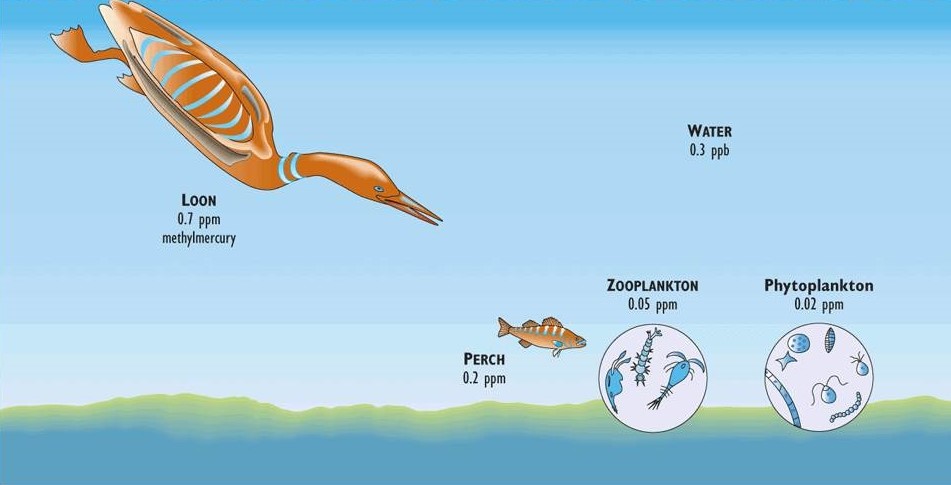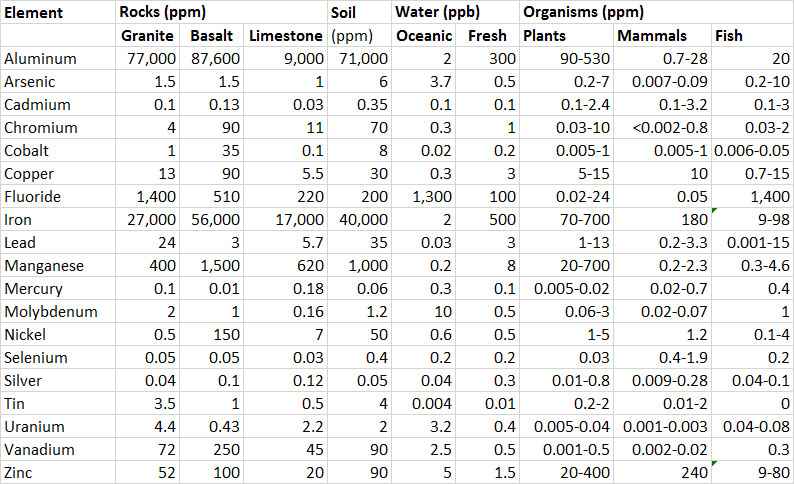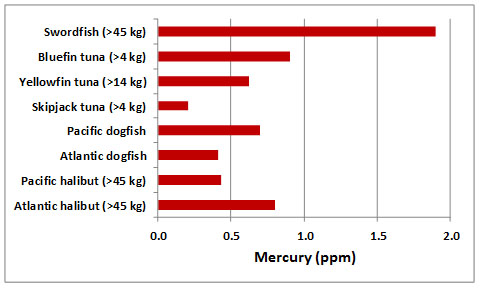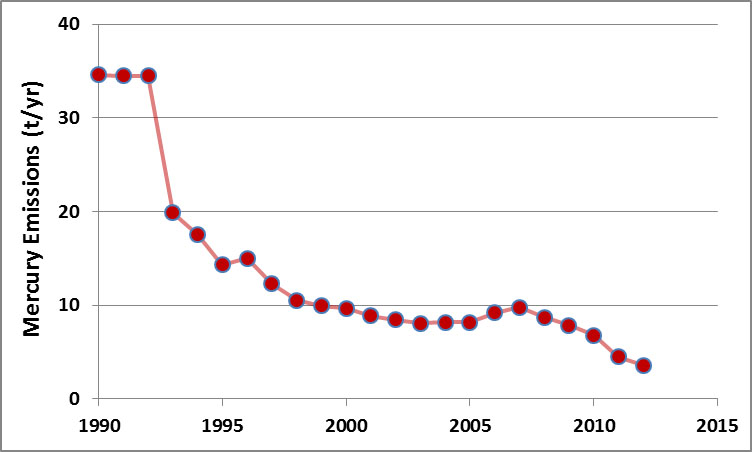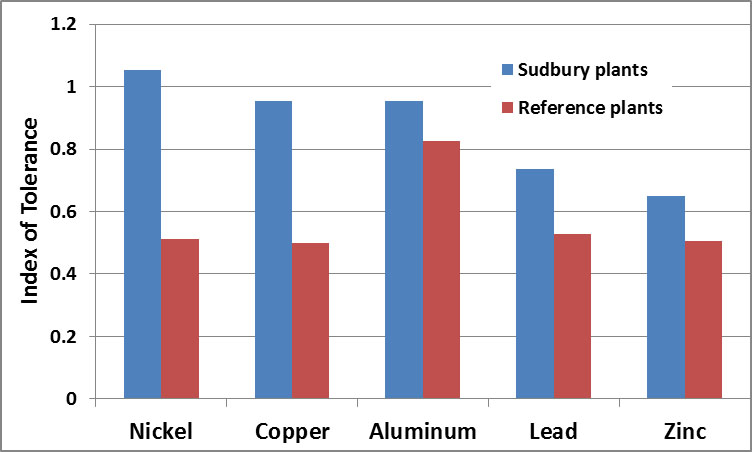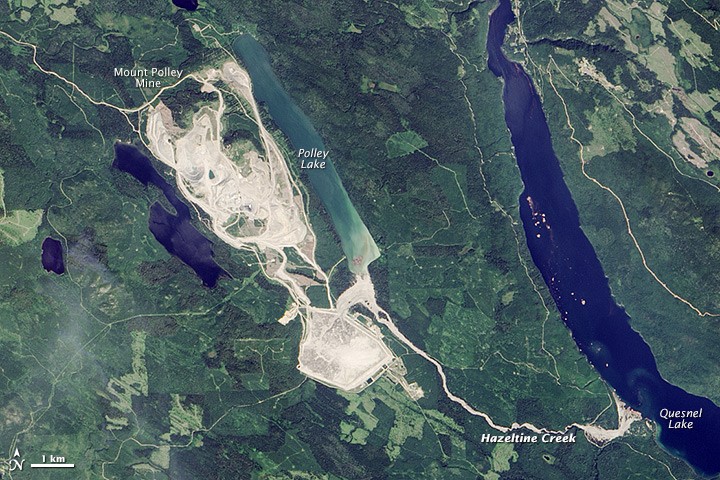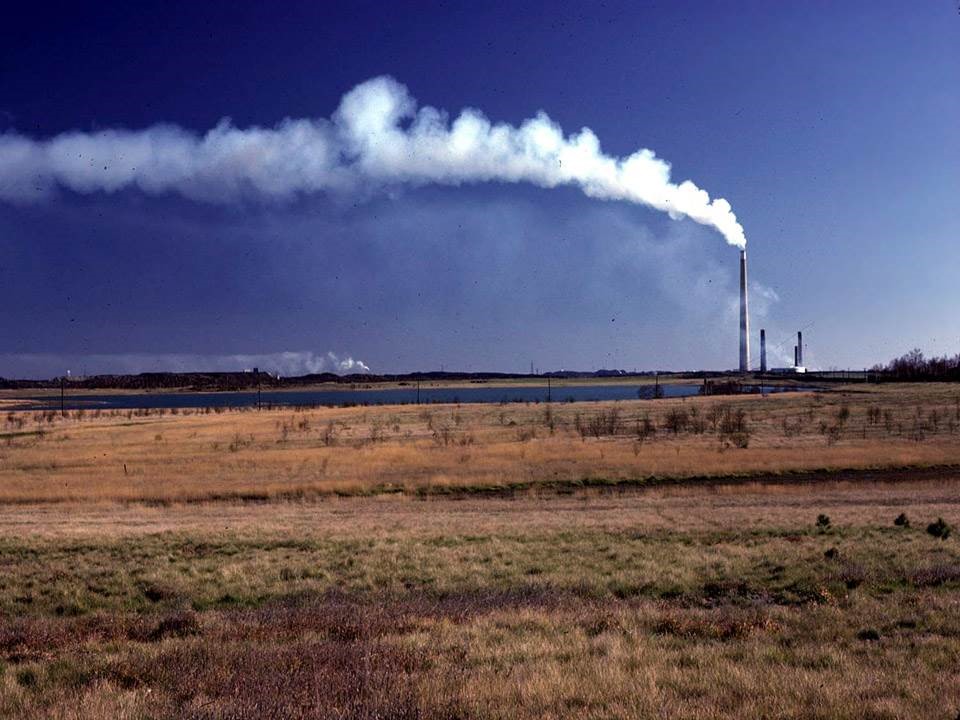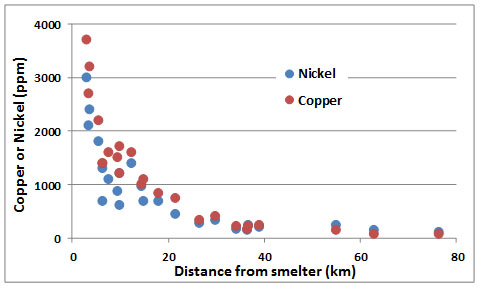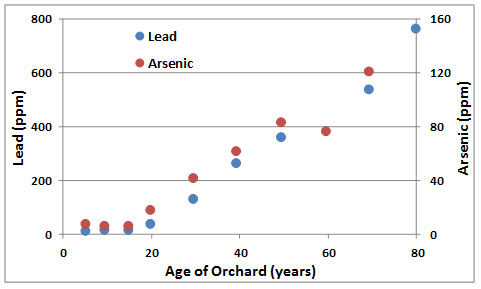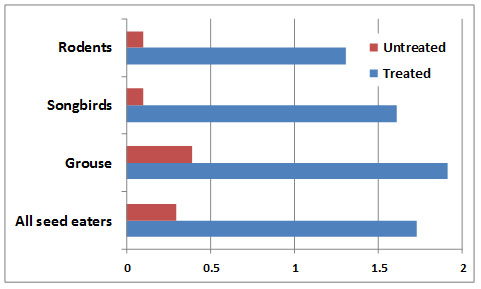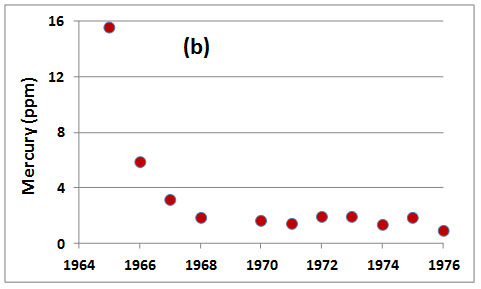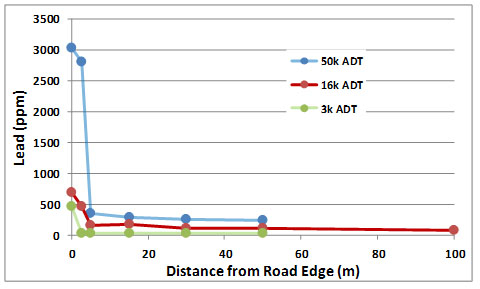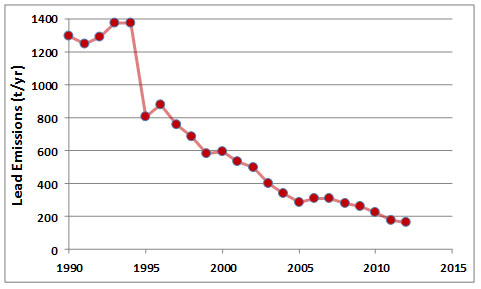Chapter 18 ~Toxic Elements
Key Concepts
After completing this chapter, you will be able to:
- Describe the ubiquitous distribution of elements in the environment and explain this phenomenon in terms of the difference between pollution and contamination.
- Outline cases of natural pollution by toxic elements and explain how they provide insight into the effects of anthropogenic pollution.
- Describe cases of anthropogenic pollution by metals and outline the resulting ecological damage.
Introduction
All of the naturally occurring metals and other elements are ubiquitous (found everywhere) in at least trace concentrations in soil, water, air, and organisms. As long as the detection limits of the available analytical chemistry are low enough, this universal contamination can always be demonstrated.
Organisms require some of the trace elements as essential micronutrients, including copper, iron, molybdenum, zinc, and in some cases aluminum, nickel, and selenium. Under certain conditions, however, these same elements can accumulate to high concentrations in organisms and cause ecological damage (see In Detail 18.1). Trace elements that are most often associated with environmental toxicity are the heavy metals cadmium, chromium, cobalt, copper, iron, lead, mercury, nickel, silver, tin, and zinc, as well as the lighter elements aluminum, arsenic, and selenium.
Some cases of elemental pollution are natural in origin. This usually involves metal-rich minerals being exposed at the surface and causing local ecological changes. However, human activities have caused additional examples of pollution by toxic elements, particularly in the vicinity of industrial sources such as smelters. In addition, emissions of mercury and lead from power plants and automobiles have caused widespread contamination of remote environments, although it is not yet certain that this is causing ecological damage.
There are cases of people having been poisoned by exposure to toxic elements in their environment. Some historians believe that the decline of the Roman Empire may have been hastened by neurotoxicity caused by chronic lead poisoning. The Romans had significant exposure to lead because they stored acidic beverages (such as wine) in pottery treated with pigments and glazes that contained lead. As well, their water piping was made of lead (the word “plumbing” is based on the Latin word for lead – plumbum). In nineteenth-century Britain, many people who made felt top-hats developed neurological damage because of their exposure to mercury compounds used to give a shiny finish to the hats – hence Lewis Carroll’s character in Alice in Wonderland, the “Mad Hatter,” and the expression “mad as a hatter.”
More recently, thousands of people suffered mercury poisoning during the 1960s after they ate grain that had been treated with mercuric fungicide. In one disastrous case in Iraq in 1971, more than 6,500 people were poisoned (about 500 died) when they ate food prepared from mercury-treated grain. The grain had been donated by a foreign aid program and was intended only for planting. Although the sacks of grain were labelled to indicate that the seeds were poisonous, many of the victims were illiterate or did not understand or ignored the implications of the message. About the same time, similar poisonings occurred when people ate mercury-treated grain in Guatemala, Iran, and Pakistan. To avoid these problems today, fungicide-treated seed-grain is usually dyed red, which warns people not to use it as food.
Mercury also caused thousands of cases of poisoning at Minamata, Japan. A factory there had discharged elemental mercury into Minamata Bay. In that form mercury is not very poisonous, but microbes in the sediment transformed the metal into methylmercury, which is extremely toxic and bio-accumulates in organisms in preference to the water of their aquatic environment. The methylmercury further biomagnified up the food web and caused extensive poisoning of fish-eating birds, domestic cats, and people (see In Detail 18,1 and Global Focus 18.1). In this chapter, we examine natural and anthropogenic pollution with toxic elements and the resulting ecological consequences.
In Detail 18.1. Bioaccumulation and Biomagnification
Certain metals or their organic compounds, such as methylmercury, tend to occur in much higher concentrations in organisms than in the ambient, non-living environment. This phenomenon is known as bioaccumulation (also called bioconcentration). Similar tendencies are shown by chlorinated hydrocarbons, such as DDT, PCBs, and dioxins (see Chapter 21). Bioaccumulation occurs because certain substances have a strong affinity for organisms and therefore concentrate within them in preference to their non-living environment. Many of these chemicals dissolve in biological fluids and tissues, such as lipid (fat), in preference to ambient water or soil.Another phenomenon, known as biomagnification (or food-web magnification), is the tendency for top predators to have the highest concentrations of these chemicals. Organisms are highly efficient at assimilating methylmercury and organochlorines from their food. Therefore, these chemicals become stored in organisms, rather than being excreted. This means that predators at the top of the food web develop the highest concentrations (residues) of these chemicals. Usually, bioaccumulation and food-web magnification progress with age, so the oldest individuals in any population are the most contaminated.
Figure 18.1. Biomagnification leads to progressively higher concentrations of methylmercury and chlorinated hydrocarbons in organisms higher in the food web. The common loon (Gavia immer) is a top predator in many lakes. In some regions of Canada, these birds can harbour concentrations of methylmercury that are high enough to impair their reproduction. The source of the environmental mercury is not yet known for certain, but it may be associated with anthropogenic emissions from power plants, incinerators, and smelters.
Concentration and Availability
All of the naturally occurring elements are present in at least trace concentrations in all samples of water, soil and rocks, air, and organisms. The term background concentration refers to a presence that is not significantly influenced by either anthropogenic emissions or unusual natural exposures. The background concentration in soil and rocks is usually much higher than in water, and also generally higher than in the tissues of organisms (Table 18.1).
However, elements that are dissolved in water often occur in chemical forms (such as ions) that are relatively easily absorbed by organisms. For this reason, even a trace aqueous concentration may be toxic. In contrast, the much higher concentrations that commonly occur in soil and rocks are mostly insoluble, and therefore are not particularly bioavailable. Scientists determine the total concentration of metals in a component of the environment (such as soil, sediment, or rock) by digesting a sample in a hot mixture of strong acid. In contrast, the “available” concentration is determined from an aqueous (water) extract of a sample. In general, the available concentration of toxic elements in soil are much smaller than the total concentrations (generally less than 1% of the total value), and it is also much more relevant to potential toxicity.
Most elements are found in only trace concentrations in the environment (Table 18.1). In contrast, aluminum and iron are prominent constituents of rocks and soil, with concentrations typically about 8% and 3-4%, respectively. However, almost all of the aluminum and iron in soil and rocks occurs as insoluble minerals that are not readily available for uptake by organisms. For example, virtually all aluminum in soil occurs as insoluble silicate and clay minerals. Although aluminum in these forms comprises about 8% of the soil mass, it is not available for uptake by plants and is therefore non-toxic. However, much smaller concentrations of aluminum, typically only a few parts per million (ppm), are found as ions, either bound to organic matter and clay surfaces or freely dissolved in soil water. The ionic forms of aluminum are readily available for biological uptake and may cause toxicity to species that are sensitive to this metal.
Much higher concentrations of soluble available aluminum occur in strongly acidic environments, especially when the pH is less than about 5.5. (In fact, almost all metals are much more soluble under acidic conditions.) Aluminum solubility is also greater in strongly alkaline environments, with pH higher than about 8. Moreover, different ionic species of aluminum occur at different pH levels:
- Al3+ is dominant in strongly acidic environments with a pH less than about 5.0
- AlOH2+ and Al(OH)2+ are important under less acidic conditions of pH 4.5–5.5
- Al(OH)3 from pH 5.2–9.0
- and AlOH4– in alkaline environments with pH greater than 8.5.
Aluminum toxicity is a common problem for organisms that live in highly acidic or alkaline environments. This is because of the combined influences of greater solubility and the presence of relatively toxic ions under those conditions.
Table 18.1. Background Concentration of Elements in Selected Components of the Environment. Source: Data from Bowen (1979).
Toxicity
The toxicity of elements and other chemicals is related to two factors: (1) the exposure (dose) and (2) the vulnerability of an organism to the particular substance. The dose received is influenced by the available concentration in the environment and the period of exposure. Therefore, a long-term exposure to only a minute available concentration may cause toxicity, especially if the element is able to bioaccumulate and then biomagnify in the food web until it exceeds a threshold of biological tolerance.
Organisms vary greatly in their tolerance of exposures to toxic elements (and to all other poisons). Consequently, an intense exposure to a potentially toxic chemical may result in some species being poisoned, while tolerant ones may not be damaged and may even benefit from the demise of sensitive species in their community. In addition, there is usually genetically based variation for tolerance within a species. This can lead to the evolution of populations (known as ecotypes) that are relatively tolerant of toxic exposures (we examine this topic in the next section).
The most common mechanism of poisoning by toxic elements is damage to an enzyme system. (Organisms have a huge diversity of enzymes, which are proteins that catalyze specific biochemical reactions and are critical to healthy metabolism.) The poisoning occurs because metal ions bind to specific enzymes, which changes their shape and results in a loss of their unique catalytic function. Toxic elements may also cause poisoning by binding to DNA or RNA, thereby disrupting transcription and translation, the processes by which genetic information is used to produce specific proteins (including enzymes; see In Detail 6.1). Toxic metals can also disrupt DNA replication and hence cell division.
Typical symptoms of acute poisoning caused by toxic elements in plants include abnormal patterns of growth, decreased productivity, impaired reproduction, the occurrence of disease, and ultimately death. Symptoms of chronic toxicity are harder to detect and may include a “hidden injury” such as a decrease in productivity that occurs without signs of acute damage. Animals can show a variety of symptoms associated with enzyme disruption, often including neurotoxicity and impaired functioning of the kidneys, liver, and other organs.
Natural Pollution
Localized natural pollution sometimes occurs when metal-rich minerals are present at the surface and are prominent in the chemistry of soil, surface water, and vegetation. These conditions can often be identified by a distinctive, stunted growth form of the vegetation, and sometimes by the presence of particular indicator plant species. In combination with chemical analyses, these biological indicators can be used to explore for metal-rich deposits, a technique known as biogeochemical prospecting.
In some cases, natural pollution by metals can be quite intense. For example, soil containing up to 3% lead plus zinc was found at a site on Baffin Island. In another case, peat filtering a spring of metal-rich groundwater in New Brunswick accumulated as much as 10% copper. High concentrations of metals in soil are also reflected in the chemistry of plants, especially in certain genetically adapted hyperaccumulator species that may occur in metal-rich habitats. For example, nickel concentrations as high as 10% have been measured in plants in the genus Alyssum growing in Russia, and up to 25% in the blue-coloured latex of Sebertia acuminata from New Caledonia in the South Pacific. These hyperaccumulator plants grow on naturally metal-polluted sites.
Serpentine Soil and Vegetation
Some well-studied cases of natural pollution involve soil influenced by serpentine minerals, which are rich in nickel, chromium, and cobalt and are associated with asbestos deposits. Soil containing serpentine minerals is toxic to non-adapted plants because of the high concentrations of these metals, in combination with an imbalance of the nutrients calcium and magnesium. Serpentine soil typically contains several thousand parts per million of nickel, but can have as much as 25-thousand ppm (or 2.5%) of this metal.
The natural vegetation on serpentine sites is often distinctively stunted. Extensive serpentine “barrens” occur in eastern Quebec and western Newfoundland. Those habitats support tundra-like ecosystems in a landscape that is otherwise covered by boreal forest.
In some places, serpentine areas support plant species that occur only in that kind of habitat, a narrow distribution that ecologists refer to as endemic. In other cases, widespread species have evolved locally adapted populations that can cope with the toxic and nutritional stresses of serpentine soil – these are known as ecotypes. On non-serpentine sites, the specifically adapted endemics and ecotypes are quickly eliminated by competition with plants that are better competitors in less-stressful habitats.
Serpentine sites in northern California support relatively ancient vegetation, because the area was not glaciated. These habitats contain at least 215 endemic species or subspecies of plants. Some of the endemics occur only on particular serpentine sites in California and nowhere else in the world. In contrast, the serpentine barrens in eastern Canada are relatively young, being released from glaciation only about 10-thousand or fewer years ago. Consequently, not enough time has passed to allow many serpentine endemics or ecotypes to evolve.
Image 18.1. An extensive area of serpentine-rich rock occurs in Gros Morne National Park in western Newfoundland. Soil rich in serpentine has high concentrations of toxic nickel and cobalt and is poor in nutrients. These conditions are stressful to plants and result in the development of stunted vegetation of limited species diversity, as in this scene. The typical vegetation on non-serpentine soil in this region is a conifer-dominated boreal forest. Source: B. Freedman.
Seleniferous Soil and Vegetation
Semi-arid regions in various parts of the world often have areas with soil that contains high concentrations of selenium. These seleniferous habitats may support plants that hyperaccumulate selenium, such as species in the genus Astragalus (locoweeds). About 25 North American species of Astragalus are hyperaccumulators of selenium. They may contain up to 1.5% of selenium in their tissues, storing it in unique amino-acid-like biochemicals, such as selenomethionine. The Astragalus species also emit dimethyl selenide and dimethyl diselenide to the atmosphere, giving them a distinctive, unpleasant odour. Livestock that feed on these plants are poisoned by a toxic syndrome known as alkali disease or blind staggers.
Mercury in Aquatic Environments
Even in remote oceanic habitats, mercury often accumulates in high concentrations (as methylmercury, CH3Hg) in fish, birds, and sea mammals. In marine waters off eastern and western Canada, large fish may have mercury concentrations in their flesh that exceed the limit considered acceptable for human consumption (more than 0.5 ppm mercury on a fresh-weight basis; Figure 18.1). Analysis of old specimens of fish and seabirds in museums has revealed levels of mercury contamination similar to those in modern samples, which suggests that the phenomenon may be natural. The contamination of marine animals represents a substantial biomagnification from ambient seawater, which has a trace concentration of mercury of less than 0.1 ppb.
Figure 18.2. Mercury Contamination of Fish Captured Offshore of North America. The data show the average mercury concentration in the muscle of species of marine fishes. The data are in ppm, measured on a fresh-weight basis. Source: Data from Armstrong (1979)
The biomagnification occur because of the progressive accumulation of mercury up the trophic web. Algae initially absorb mercury from the water (as methylmercury), and zooplankton accumulate even larger residues as they graze on the algae. Zooplankton-eating fish accumulate still larger quantities, but the largest residues occur in long-lived top predators, such as big fish and marine mammals (see In Detail 18.1).
Within any particular species of fish, larger (and older) individuals generally have higher mercury concentrations than smaller (and younger) ones. A study of swordfish caught off eastern Canada found that animals heavier than 45 kg had an average mercury concentration of 1.1 ppm, while those weighing 23-45 kg had 0.86 ppm, and those smaller than 23 kg had 0.55 ppm (Armstrong, 1979). It appears that mercury residues become more intense as the animals age and grow larger.
High concentrations of mercury also occur in fish-eating marine mammals and birds, which are top predators in their ecosystem. Studies of adult harp seals (Phoca groenlandica) in eastern Canada found an average mercury concentration of 0.34 ppm in muscle and 5.1 ppm in the liver (Armstrong, 1979). High mercury residues also occur in North Atlantic seabirds, with an average of 7 ppm found in feathers of northern skua (Catharacta skua), 5 ppm in puffin (Fratercula arctica), and 1-2 ppm in fulmar (Fulmarus glacialis), kittiwake (Rissa tridactyla), razorbill (Alca torda), and common murre (Uria aalge) (Thompson et al., 1991).
Mercury contamination of fish has also been observed in many remote lakes. For example, about three-quarters of 1,700 lakes monitored in Ontario have fish with mercury exceeding 0.5 ppm fresh weight in their flesh. In a remote lake in northern Manitoba, the average mercury concentration in muscle of 53 northern pike (Esox lucius) was 2 ppm fresh weight and one animal had 5 ppm (McKay, 1985). In general, freshwater fish that are top predators have the highest residues of mercury, and larger or older individuals are the most contaminated.
Federal, provincial, and territorial governments in Canada issue advisories about eating fish taken from particular lakes and rivers where mercury residues are known to be a problem; the advisories may also have information about other contaminants, such as PCBs and dioxins. In Ontario, for example, more than 2,200 waterbodies are monitored for this purpose (MOEE, 2014). The advisories tell people how many fish of particular species and sizes they can eat. The general threshold is 0.61 ppm, but it is as low as 0.26 ppm for pregnant women and children, and no fish with more than 1.84 ppm should be consumed. About one-third of the advisories given for sportfish taken from Ontario lakes result in some level of consumption restriction. In Sweden, about half of the lakes have some fish with mercury exceeding the health advisory limit (0.5 ppm), and hundreds of lakes have been blacklisted because their fish are considered unfit for human consumption.
The causes of mercury contamination of lakes are not known for certain. It seems likely that the phenomenon may be natural in regions that are remote from sources of emission. However, anthropogenic mercury is contributing to the problem closer to large emissions sources, such as coal-fired generating stations, municipal incinerators, and smelters. For example, Harp Lake in Ontario is located relatively close to municipal and industrial sources of emissions. Studies found that atmospheric deposition accounted for 57% of the mercury input to that lake, suggesting a significant anthropogenic influence (Mierle, 1990).
The above discussion of mercury in lakes refers to the many situations in which there are no direct anthropogenic inputs of the metal. However, there are well known cases of pollution caused directly by industrial releases. For example, discharges from chlor-alkali and acetaldehyde factories and some older pulp mills have caused local mercury pollution, resulting in high residues of methylmercury in fish and other animals. The case of Minamata Bay, Japan, involved an acetaldehyde plant (Global Focus 18.1). A less severe case in Canada, which affected parts of the English and Wabigoon Rivers in northwestern Ontario, involved a pulp mill.
Significant bioaccumulation of mercury also occurs when hydroelectric reservoirs are developed (see Chapter 20). Flooding leaches naturally occurring soil mercury into the reservoir, where bacteria in oxygen-poor sediment transform it into methylmercury that is biomagnified by fish. This process occurs more rapidly in acidic lakes because that condition favours the production of methylmercury in the sediment, compared with less available dimethylmercury in non-acidic waterbodies.
Although there is some controversy about the relative importance of natural and anthropogenic sources of mercury to remote lakes, it is reassuring to know that the overall emissions have been greatly reduced in recent decades (Figure 18.3). This occurred because of improved emissions controls at industrial facilities, including the closing of several metal smelters and coal-fired power plants.
Figure 18.3. Mercury Emissions in Canada. Source: Data from Environment Canada (2015).
Global Focus 18.1. Mercury in Minamata Bay
Minamata is a city in Japan where industrial emissions from a factory caused a famous example of toxic pollution, beginning in the 1950s. The factory produced acetaldehyde, which is used to make plastics. The industrial process used inorganic mercury as a catalyst, and between 1932 and 1968, about 25 tonnes of the metal was dumped into Minamata Bay with wastewater discharges. Bacteria in anaerobic sediment transformed the mercury into methylmercury, which became biomagnified in fish to resides as high as 20 ppm. The fish were eaten by predatory birds, causing toxicity and reproductive failure. Fish and shellfish were also harvested and eaten by people living around the bay, which has a long-standing, traditional fishing economy. This caused an episode of toxicity that became known as “Minamata Disease.”It took several years for the complex of symptoms caused by methylmercury poisoning to be recognized as being ultimately due to emissions from the acetaldehyde factory. Initially, in the mid-1950s, doctors noticed that people were displaying a novel and strange neurological syndrome, characterized by progressive degeneration of the nervous system. Symptoms intensified from numbness in the limb extremities, to slurred speech, loss of peripheral vision, convulsions, unconsciousness, and ultimately the death of many victims. There was also a congenital syndrome caused by toxicity to fetuses by methylmercury passed across the placental barrier. Afflicted children suffered from deformity, mental retardation, and impaired motor control. At the same time, fish-fed cats were killed by a neurological disease, as were fish-eating birds.
It soon became apparent that the disease was being caused by eating fish harvested from Minamata Bay. Although industrial waste being dumped into the bay was an early suspect, not much was initially done to either reduce the discharges or to prevent people from eating seafood caught in the polluted area. Then, in 1959, scientists from Kumamoto University concluded that an organo-mercurial compound was the cause of the toxic syndrome. Soon after, it was realized that its origin was inorganic mercury of industrial origin that was being naturally methylated in the bay. The company that caused the pollution challenged these conclusions, although it began to pay compensation to some of the most severely afflicted people (but only if a release was signed that absolved the company of responsibility and eliminated the possibility of future lawsuits; moreover, many affected people were denied compensation). Despite intense controversy, the company continued to release mercury to the aquatic environment until 1968, when a change in technology eliminated it from the manufacturing process.
Ultimately, about 2,200 people were officially diagnosed as having Minamata Disease as a result of exposure to methylmercury in seafood harvested from the bay. Of these, about 100 died of their poisoning. In addition, at least 12-thousand people may have suffered milder forms of the disease but were not officially diagnosed. In 1973, a court found the chemical company to have behaved in a negligent manner and to be liable for the damages. Many people suffering from mercury-caused disease were awarded compensation, although the amounts paid were disputed as being insufficient and many people received nothing. The bottom line, however, is that people died of avoidable methylmercury poisoning, and many survivors experienced terrible physical and mental disabilities.
Important lessons can be learned from this environmental catastrophe. One is that unanticipated consequences may result from human activities that are thought to be environmentally safe. In the Minamata case, it was believed that the dumping of wastewater containing inorganic mercury would not cause serious damage to the marine environment. At the time, it was not known that bacteria in sediment are capable of transforming mercury into bio-magnifying and toxic methylmercury. Moreover, even when it was recognized that this was happening, and that people and wildlife were being poisoned, business interests and regulatory and political authorities did not act decisively to ensure that people were no longer exposed to the toxic threat. This negligence greatly compounded the problem.
In any event, the tragic case of Minamata Bay has improved our understanding of the consequences of discharging mercury into an aquatic environment. However, the broader lesson about unintended consequences of poorly considered economic activities is not yet firmly enshrined in our planning and regulatory systems.
Anthropogenic Sources
Industrial processes used to mine, process, and use metals can result in the pollution of air, water, and land (refer to Figure 13.1).
Mining Residues
Areas near mine sites may be badly damaged by the dumping of metal-rich excavation waste (rocks whose metal concentration is not high enough to be considered commercial ore). Because these materials may be toxic, vegetation development can be restricted to early successional communities, such as sparse grassland. In some cases, soil toxicity is severe enough that few plants manage to establish even after hundreds of years. This can be seen on mine wastes from 2000-year-old Roman lead workings in England and Wales.
Ecologists studying British sites polluted by mine wastes have found that these habitats often support plant ecotypes that are genetically tolerant of the metals that are present. The locally adapted ecotypes can grow in metal-polluted soils, where non-tolerant plants are eliminated by the toxic stress. Conversely, the tolerant ecotypes are poor competitors in non-polluted environments, and so are rare in habitats unaffected by metal toxicity.
Research into metal-tolerant ecotypes has provided insights into the process of evolution (Chapter 6). Metal-tolerant individuals do occur in populations growing on non-polluted sites, but they are rare. However, the frequency of tolerant genotypes increases quickly after metal pollution occurs. In places with sharp boundaries between polluted and non-polluted soils, a tolerant population can maintain itself over a distance of only a few metres. This is possible because the intense toxicity of polluted soil strongly favours the survival and reproduction of tolerant individuals. Such a population-level change in genetically based characters, occurring in response to an agent of natural selection (in this case, metal pollution), is a demonstration of evolution (more specifically, microevolution).
Metal-tolerant ecotypes have been studied near Sudbury, where pollution by nickel and copper has been caused by emissions from smelters and roast beds (see Chapter 16). Plant communities of polluted sites are dominated by metal-tolerant ecotypes of several grasses, particularly Agrostis gigantea and Deschampsia caespitosa. Meadows of these grasses developed soon after the extremely tall “superstack” was commissioned in 1972. Because it dispersed emissions widely, the superstack greatly reduced ground-level SO2 pollution. However, soil in the area remained acidic and polluted with metals. The local ecotypes of these grasses can tolerate toxic stress from acidity and metals, but are intolerant of SO2, which is why the grasslands did not develop until after the superstack began to operate.
The metal tolerance of the grass Deschampsia caespitosa has been studied. Plants were grown in solutions containing the metals of interest, and were compared with controls (Figure 18.3). The data show that the Sudbury population is tolerant of nickel and copper, which occur in their native soil at concentrations of about 400 ppm, compared with 20 ppm at non-polluted reference sites. The Sudbury population is also more tolerant of aluminum. This is a response to the greater solubility and toxicity of aluminum in acidic soil near the smelters (which had a pH of 3.5-3.9, compared with pH 6.8-7.2 at reference sites).
Figure 18.4. Tolerance of a Grass to Metals. Populations of the hairgrass (Deschampsia caespitose) were collected from metal-polluted places near Sudbury and from reference sites where metals are not a problem. The index of metal tolerance is based on the root growth that occurs when plants are grown in solutions containing metals, compared with a no-metal control. The larger the index number, the greater the tolerance. In all comparisons presented here, the two populations had statistically significant differences in tolerance to the metal tested, with a probability level of <0.001, except for aluminum (p < 0.05; note: a probability value of <0.001 means that there is less than a 0.1% (or 1/1000) likelihood that the difference between the two populations is due to chance alone; p <0.05 means there is less than a 5% chance). Source: Data from Cox and Hutchinson (1979).
Metal-Containing Tailings
Once ore is mined, it is ground to a fine powder in a process called milling. The powder is then separated into a valuable metal-rich fraction, which is roasted and smelted, plus large quantities of waste tailings. In most cases, the tailings are dumped into a low-lying contained area, which when full is covered with vegetation as a stabilization measure. Although the tailings are a waste product, they still contain high concentrations of metals, and that can make it difficult to establish vegetation after a dump is filled. In addition, if sulphide minerals are present, acidity is generated when they become oxidized by bacteria, and that makes the toxicity worse. Chemical analyses of tailings from several Canadian mines are shown in Table 18.2. The tailings contain high concentrations of various metals, depending on the ore being processed. The acidic tailings are especially toxic, because metals are much more soluble and bioavailable under acidic conditions.
Table 18.2. Chemical Analyses of Metal-Contaminated Tailings. Samples were taken from sites in the Yukon and northern Ontario. Metal data are in ppm, sulphur in %. Data modified from Kuja (1980).
Canadian regulators require that tailings-disposal areas be covered with vegetation once they are full of waste or after their associated mine closes. This is done because tailings dumps have poor aesthetics and can be sources of wind-borne dust. These environmental problems can be substantially mitigated if an abandoned tailings dump is covered with a stable cover of vegetation. In addition, if their associated dams and berms are not structurally sound and become breached by high water flows during severely rainy weather, tailings-disposal areas can be a source of massive water pollution.
One such disaster occurred in 2014 in the Cariboo region of central British Columbia, when an accidental breach occurred at the tailings disposal area of a copper- gold mine at Mount Polley. The massive spill involved about 10-million cubic metres of water and 4.5-million cubic metres of slurry (a fluid mixture of tailings particles and water) (Allen and Voiland, 2014). The great scouring flow eroded banks and uprooted trees and much of the volume eventually deposited into nearby Polley Lake, whose surface rose by 1.5 metres. Some of the flow then continued via Hazeltine Creek into the much larger Quesnel Lake, which had been famous as a deep, pristine waterbody. By the end of the day of the breach, the 4-km2 tailings pond was almost empty. In this case, the cause of the breach appears to have been over-filling of an under-engineered tailings disposal area.
Image 18.2. A catastrophic release of tailings occurred at the Mount Polley mine in 2014. The top image shows the tailings-disposal area prior to the breach, with the light-blue colour representing the area where wastes were being dumped. The bottom image shows conditions after the breach, with almost all of the volume of the dump site having escaped to Polley Lake and some also to Quesnel Lake. Source: NASA (2014).
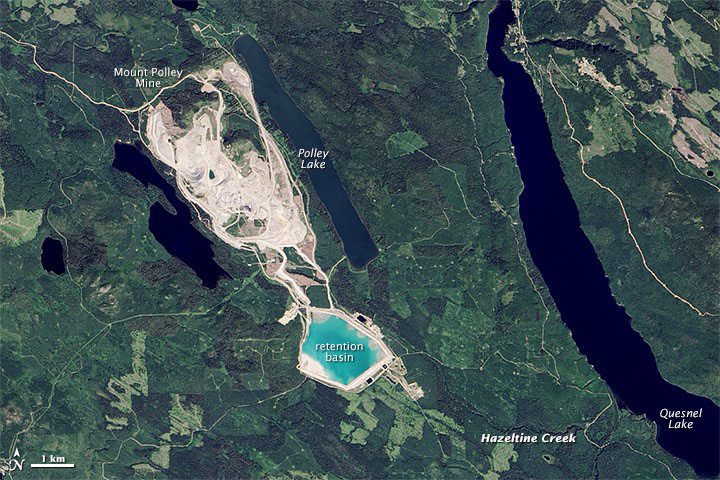
If a filled-up tailings-disposal area is to have a stable cover of vegetation established on top, its contents must be treated to reduce the toxicity. If the tailings are acidic, a liming treatment is needed to raise the pH to a neutral level and so reduce the availability of metals. Fertilizer may also be used to alleviate nutrient deficiency and organic matter added to improve soil structure and water-holding capacity, and then plants are sown. Sometimes, novel techniques are used, such as the use of acid- or metal-tolerant ecotypes in the planting mixture. If the tailings are extremely toxic or acid-generating, they may have to be covered with a locally available overburden, such as glacial till, which is then vegetated. Canadian Focus 18.1 describes the reclamation of tailings-disposal areas in the vicinity of Sudbury.
Image 18.3. Tailings are the fine waste that remains after ore is ground and processed to remove metal-rich minerals. Tailings contain high concentrations of metals and can generate acidity when exposed to the atmosphere. These conditions make it difficult to establish vegetation after disposal sites are filled. This is a view of a reclaimed area of tailings near Sudbury. Most of the vegetation was sown, but native shrubs and trees are also becoming established. Source: B. Freedman.
Canadian Focus 18.1. Tailings Reclamation at Copper Cliff
A large smelter at Copper Cliff, near Sudbury, is serviced by a mill that produces large amounts of tailings (54-thousand tonnes per day at the time the case study of Peters (1984) was written). The tailings are mixed with water and piped as a slurry to be disposed in natural basins whose capacity is increased by the construction of earthen dikes. In 2005, the tailings dumps covered about 3,025 ha, of which 1,425 ha had been stabilized by a cover of perennial vegetation. The vegetation prevents fine dust from blowing into the atmosphere and improves aesthetics and environmental quality. The re-vegetated tailings areas have a central pond, which is surrounded by gradually sloping grassland.The tailings are a finely ground material, composed mainly of minerals that are not particularly toxic. However, the tailings contain pyrites that oxidize when exposed to atmospheric oxygen, and generate acidity as low as pH 3.7. These extremely acidic conditions result in metals becoming available for plant uptake, which greatly increases the toxicity of the tailings. Plant-available metals were analyzed by extracting tailings with acetic acid, and very high levels of available metals were found, with nickel up to 87 ppm, copper 81 ppm, and iron 440 ppm.
The reclamation procedures result in a stable grassland being established, which is then invaded by native shrubs, trees, and other plants. The methods include the following:
- application of 900 kg/ha of limestone (CaCO3), which raises the pH of the tailings to 4.5-5.5 and reduces the availability of metals
- several applications of fertilizer during the initial stages of grassland establishment, with nitrogen being especially important
- application of an organic mulch to improve the water-holding and aeration characteristics of the surface tailings
- sowing with a mixture of long-lived pasture grasses and legumes, as well as annual rye (Secale cereale), which provides a short-lived nurse crop that helps mitigate the stressful microclimate for tender seedlings of the perennial grasses and legumes
As vegetation establishes and develops on the reclaimed tailings-disposal areas, some animals begin to use the habitat. Birds that breed in the grassy habitat and its central pond include mallard and black ducks (Anas platyrhynchos and A. rubripes), American kestrel (Falco sparverius), killdeer (Charadrius vociferus), and savannah sparrow (Passerculus sandwichensis). At least 90 species of birds have been observed to use the reclaimed tailings dump and its pond during migration.
Smelters
A smelter is a large industrial facility where ore is roasted. This is done to oxidize sulphide minerals, a process that results in large amounts of waste SO2 and metallic particulates. In most cases today, pollution-control technologies are used to recover much of the SO2 and particulates before the flue-gases are vented to the atmosphere. In the past, however, those wastes were emitted into the environment, causing intense pollution and ecological damage. As recently as several decades ago this was a common practice, and it still is for some older smelters. Newer smelters operate much more cleanly.
A smelter is a point source of toxic stress to surrounding ecosystems. Emissions may result in well-defined spatial gradients of both pollution and its resulting ecological damage, which diminish with increasing distance. Studies of damage near smelters indicate the following generalizations:
- Close to the point source, pollution by atmospheric SO2 and metals in soil is most severe
- The intensity of pollution decreases rapidly (more or less exponentially) with increasing distance from the smelter.
- Damage to vegetation varies with the intensity of toxic stress and includes decreases in biomass, productivity, and species diversity, with only a few low-growing species occurring in the most polluted habitats
- Ecological processes such as nutrient cycling and decomposition are disrupted by toxic metals, gases, and acidity
The pattern of metal pollution around a point source can be illustrated by the Copper Cliff smelter near Sudbury. Figure 18.4 shows that metal concentrations in the environment decline rapidly with increasing distance from that smelter. These data specifically refer to the forest floor, but similar observations are seen in soil, vegetation, lakewater, and other components of the ecosystem.
Figure 18.5. Metal Pollution near Sudbury. Decades of emissions of metals from the Copper Cliff smelter caused an accumulation of nickel and copper in the environment. The most intense pollution occurs close to the point source. These data are for metals in the forest floor, which is the organic-rich layer that overlies the mineral soil. The forest floor binds metals in organic complexes and accumulates higher residues than the underlying soil. The samples were collected along a transect running south from the smelter. The spatial patterns of copper and nickel are highly correlated, with a coefficient of 0.98. Source: Data from Freedman and Hutchinson (1980)
As we examined in Chapter 16, SO2 has also been an important pollutant in the Sudbury area. Consequently, it is difficult to determine the specific role of toxic metals in causing ecological damage. One way to investigate the influence of metals is to grow plants in polluted soil in a greenhouse, where SO2 is not present. These bioassay experiments have demonstrated that soil collected near the smelters is toxic, mainly because of its high concentrations of metals. To a substantial degree, the toxicity persists even after the soil acidity is neutralized by adding lime.
Not all smelters emit both SO2 and metals. The ecological damage that results from those that emit only metallic particulates has consequently been caused by metal pollution. One well-studied smelter, at Gusum, Sweden, has operated since 1661 (Tyler, 1984). Zinc is an important pollutant there, reaching concentrations as high as 2% (20-thousand ppm) in surface organic matter close to the point source, compared with less than 200 ppm farther than 6 km away. Copper pollution is similar, reaching 1.7% within 0.3 km, compared with 20 ppm beyond 6 km. The zinc and copper pollution has caused local ecological damage. Pine and birch trees have died or declined close to the source, and understorey plants, mosses, lichens, and soil-dwelling invertebrates have been damaged. Rates of decomposition and nutrient cycling are also impaired in the most polluted sites. Some plants, however, are tolerant of the metal pollution at Gusum. They include the grass Deschampsia flexuosa and the moss Pohlia nutans, which do relatively well in sites that are toxic to other plants.
Use of Inorganic Pesticides
Until the 1970s, inorganic chemicals were widely used as pesticides in agriculture (see also Chapter 22). This was especially true in fruit orchards, where pesticides based on lead arsenate, calcium arsenate, copper sulphate, and related compounds were used to control fungal diseases and arthropod pests. These compounds have now been largely displaced by synthetic organic pesticides.
However, until the mid-1970s, annual spray rates of lead in Ontario orchards were as high as 8.7 kg/ha, while arsenic treatments reached 2.7 kg/ha, zinc 7.5 kg/ha, and copper 3.0 kg/ha (Frank et al., 1976). The spray rates depended on the crop being grown, the pest being managed, and the pesticide used, but in some cases all of these toxic elements were applied in the same orchards.
Residues of these chemicals accumulated in the soil of treated orchards. Studies of apple orchards found residues as high as 890 ppm of lead and 126 ppm of arsenic in surface soil, compared with background levels of <25 ppm lead and <10 ppm arsenic (Figure 18.5). The accumulations were caused by up to 70 years of spraying lead arsenate as an insecticide, mostly against the codling moth (Laspeyresia pomonella), a pest that causes “wormy” apples.
Figure 18.6. Accumulation of Arsenic and Lead in Orchards. Lead arsenate was used as an insecticide to combat infestations of apple orchards with codling moth. These data show the progressive accumulation of arsenic and lead in soils of orchards in southern Ontario. The largest residues are in the oldest orchards, which had been sprayed for many years. The background concentration for lead is 20 ppm, and for arsenic it is 10 ppm. Source: Data from Frank et al. (1976).
Agricultural soil can also be contaminated by the use of mercury-containing fungicides, especially those that protect newly germinated seedlings from a fungal infection known as damping-off. This pathogen attacks seedlings at the soil-air interface and causes the weakened plant to fall over and die. Mercury-containing pesticides are also used to control turfgrass diseases on golf-course putting greens. Mercury residues ranging from 24-120 ppm have been measured in the soil of putting greens in Ontario, while up to 9 ppm was found in Nova Scotia. The sowing of seed coated with mercuric fungicide has caused poisoning of wild animals that consumed the planted grain or ate herbivores that did so. Alkyl-mercury compounds such as methylmercury are especially hazardous in this respect because this form is extremely toxic and readily assimilated by animals from their food. Figure 18.6 shows the mercury contamination of seed-eating wildlife in regions of Alberta where treated seed was used, compared with areas where that exposure did not occur. Use of these fungicides was common until the early 1970s.
Figure 18.7. Mercury in Animals Feeding on Treated Seed. Seed-eating rodents and birds were exposed to alkyl-mercury fungicide by feeding on treated seed in agricultural areas in Alberta. Data are also presented for an area where mercury-treated seed was not used (labelled as untreated). The data are average data for liver and are in ppm dry weight. Source: Data from Fimreite et al. (1970).
Beginning in the late 1960s, most developed countries prohibited the use of alkyl-mercury fungicides as seed dressings. This ban resulted from the recognition of ecological problems associated with use of these chemicals, especially the poisoning of wild animals. Sweden, for example, prohibited the use of these pesticides in 1966, while approving the use of alkoxyl-alkyl-mercury compounds, which are much less toxic, as replacements. This action rapidly led to decreased mercury contamination of wildlife, such as predatory birds (Figure 18.7). Canada took similar action, although several years later.
Figure 18.8. Mercury Contamination of Swedish Hawks. (a) Mercury in feathers of goshawks (Accipiter gentilis), during various time periods; (b) Mercury in feathers of marsh harriers (Circus aeruginosus). Note the large increase in contamination caused by the use of alkyl-mercury fungicides and the rapid decrease that followed the banning of these chemicals in 1966. Source: Data from Johnels et al. (1979).
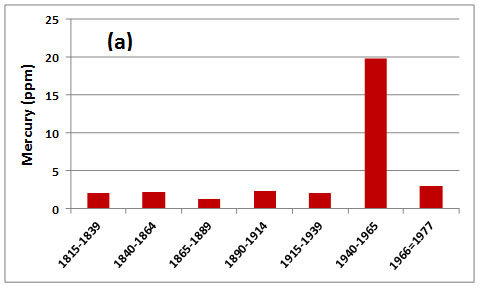
As was noted in the introduction to this chapter, humans have also been poisoned by inadvertently eating mercury-treated seed grain.
Birds and Lead
Millions of birds have suffered lead poisoning in North America each year because they ate spent shotgun pellets. Most of the spent shot was associated with hunting. In Canada, for example, about 2000 tonnes of lead shot were used by hunters each year in the early 1990s. Although more localized, skeet shooting was also a problem because of the large amount of shot deposited, up to tonnes of lead each year.
After being ingested by a seed-eating bird, lead shot may be retained in the gizzard, a muscular forepouch of the stomach. Hard grit is normally retained in the gizzard and used to grind tough-coated seeds, aiding in their digestion. Unfortunately, shotgun pellets are similar in size and weight to the grit that many birds select for this purpose. The shot becomes abraded in the gizzard, and the bits are swallowed and dissolved by acidic stomach fluid. The lead is then absorbed into the bloodstream, allowing it to poison the nervous system of the bird, leading to death.
Waterfowl have been especially widely affected, with 2-3 million individuals, or 2-3% of the North American population, dying each year from lead-shot poisoning in the early 1990s. The retention of just one or two pellets in its gizzard can poison a duck, causing a wasting away of 30-50% of its body weight, neurological toxicity, and ultimately death. Typically, about 10% of the waterfowl surveyed in North America had one or more shotgun pellets in their gizzard. Larger aquatic birds, such as swans, are known to retain lead fishing weights in their gizzard. Lead sinkers or shot were cited as the cause of 20-50% of the mortality of trumpeter swans (Cygnus buccinator) in western North America. Lead sinkers are also known to poison tundra swans (C. columbianus) wintering in the eastern United States, mute swans (C. olor) in Europe, and common loons (Gavia immer) in Canada and the United States. In Canada, about 500 t/y of lead fishing sinkers and jigs were lost in the early 1990s.
A related syndrome, caused by ingesting lead shot and bullets, afflicts birds that scavenge dead carcasses. Although the numbers are not well documented, this poisoning is known to kill vultures, eagles, and other scavenging birds. The critically endangered California condor (Gymnogyps californianus) has been relatively well studied – about 60% of its known deaths in the wild between 1980 and 1986 were caused by toxicity from ingested bullets in carrion. Because of the widespread poisoning of birds by lead shot, regulators have now restricted its use. Lead shot is banned over most of the United States. In Canada, the use of non-toxic shot has been required in all wetland areas since 1997 and in all other hunting areas since 1999. The use of lead shot for hunting is being replaced mostly by steel shot, and to a lesser degree by bismuth shot. The restricted use of lead shot has caused some controversy because many hunters believe that the alternative shot types might cause more crippling deaths. However, field tests have shown this effect to be marginal, as long as the inferior ballistic qualities of the alternatives are compensated for by shooting at closer distances or by using a larger size of shot.
Automobile Emissions of Lead
Lead emitted by automobiles has contributed to a general contamination of urban environments. From 1923, but particularly after 1945, tetraethyl lead was added to gasoline as a so-called “anti-knock” compound. The lead increases mechanical efficiency and gasoline economy, while decreasing engine wear. In 1975, about 95% of the gasoline used in North America was leaded at concentrations as high as 770 ppm. In 1987, only 35% of the gasoline was leaded, and the maximum permitted then was 290 mg/L. The decreased use of lead between 1975 and 1987 was mostly due to the increased use of catalytic converters to reduce emissions of other automobile pollutants, especially carbon monoxide and hydrocarbons. Automobiles equipped with a catalytic converter can only use unleaded gasoline, because the catalysts, usually platinum, are rendered inactive by lead. The increasing use of unleaded fuels resulted in a 93% decrease in lead particulates in the air of Canadian cities between 1977 and 1989.
After 1990, the use of leaded gasoline was banned in Canada and the United States (the only exceptions were low-lead fuels [up to 30 ppm] for use in some farm vehicles, marine engines, and large trucks). Consequently, emissions of lead from automobiles in Canada decreased from about 9,500 t in 1978 to less than 100 t/y since 1995. However, many other countries, particularly in the less-developed world, continue to allow the use of leaded fuels.
Almost all of the lead in gasoline is emitted as particulates through the vehicle tailpipe. The larger particulates settle out close to the roadway. This results in the buildup of a well-defined gradient of lead pollution, the intensity of which is related to traffic volume. This pattern of roadside pollution is illustrated in Figure 18.8 (this study was made prior to the banning of leaded fuels). Finer lead particulates are more widely dispersed in the atmosphere and contribute to the general contamination that occurs in cities. Not surprisingly, studies have shown some effects of lead on urban wildlife. For example, pigeons (Columba livia) living in cities can have significant residues of lead and may exhibit symptoms of acute poisoning.
Figure 18.9. Lead Pollution and Vehicular Traffic. Soil was collected near roads of different traffic density in Halifax, and was analyzed for its lead content. Metal data are in ppm dry weight, while average daily traffic (ADT) is in vehicles per day. The background concentration in soil is 14 ppm. Source: Data from Dale and Freedman (1982).
Overall, there have been large reductions in the emissions of lead in Canada, and also in other developed countries (Figure 18.9). This improvement in environmental conditions has occurred because of the banning of leaded gasoline as well as improved emissions controls at smelters and other industrial facilities.
Figure 18.10. Lead Emissions in Canada. The especially large decrease in 1995 was due to the banning of leaded gasoline, and much of the continuing reduction was due to improvements of industrial practices. Source: Data from Environment Canada (2015).
Conclusions
All of the naturally occurring elements are present in at least a trace level of contamination in all components of the environment – in the air, water, soil, and organisms. Sometimes their concentration is naturally elevated, as occurs when an ore body is present at the surface of the ground. Increasingly, however, anthropogenic activities are responsible for large emissions of toxic elements to the environment, and in some cases this has resulted in serious damage to ecosystems and in toxicity to people. The worst cases of pollution involve industrial practices that are no longer allowed in Canada or other wealthy countries, such as uncontrolled emissions of metals from smelters, the dumping of mercury into aquatic environments, the use of leaded gasoline, and the use of lead shot for hunting. Nevertheless, pollution by toxic elements is still an important problem. Damage is still being caused to ecosystems and organisms by releases of lead, mercury, and other toxic elements. This is true of all parts of the world, although pollution by toxic elements in poorer countries is much less controlled than in wealthier ones.
Questions for Review
- How can we identify normal (or reference) levels, contamination, and pollution by metals and other elements given that these substances are ubiquitous in the environment?
- What are the important sources of metal emissions to the environment?
- What is the difference between the total and available concentrations of metals?
- Describe the spatial pattern of metal pollution around a large point source of emissions, such as a smelter.
Questions for Discussion
- Do you think that environmental damage similar to that near Sudbury is likely to be caused if a new smelter is constructed to process the ore mined at the ore deposit at Voisey’s Bay, Labrador? (Note that the ores in both cases are similar – they contain sulphide minerals of nickel and copper.)
- Important environmental benefits have been gained by banning the use of leaded gasoline in Canada. Why were there long delays in taking similarly vigorous actions against the use of lead shot in hunting and skeet shooting and lead weights in fishing?
- Pick an element that was examined in this chapter and research its benefits, toxicity, effects on the environment, control, and mitigation.
- Explain the principles of bioaccumulation and biomagnification using the case of methylmercury in aquatic ecosystems. Why do you think these phenomena were unanticipated “surprises” to environmental scientists?
Exploring Issues
- Assume that Canada and the United States are negotiating a treaty to govern their emissions of mercury to the environment. You are a science advisor to the Canadian team. Some members of the team want to press for a “zero emissions” policy, believing that no emissions of mercury to the environment are acceptable. They ask for your advice on this issue. What kinds of information about the toxicity of mercury, to humans and to wild ecosystems, do you need in order to give the team objective advice about the proposed zero-emissions policy? Also, is it physically possible to have zero emissions?
References Cited and Further Reading
Allen, H.E., A.W. Garrison, and G.W. Luther III. 1998. Metals in Surface Waters. Ann Arbor Press, Chelsea, MI.
Allen, J. and A. Voiland. 2014. Dam breach at Mount Polley mine in British Columbia. NASA (Visible Earth). http://visibleearth.nasa.gov/view.php?id=84202 Retrieved January, 2015.
Alloway, B.J. (ed.). 2012. Heavy Metals in Soils: Trace Metals and Metalloids in Soils and their Bioavailability. 3rd ed. Springer, New York, NY.
Armstrong, F.A.J. 1979. Mercury in the aquatic environment. Pp. 84-100 in: Effects of Mercury in the Canadian Environment. NRCC No. 16739, National Research Council of Canada, Ottawa, ON.
Bowen, H.J.M. 1979. Environmental Chemistry of the Elements. Academic Press, New York, NY.
Bradshaw, A.D. and M.J. Chadwick. 1981. The Restoration of Land. Blackwell, Oxford, UK. Cox, R.M. and T.C. Hutchinson. 1979. Metal co-tolerances in the grass Deschampsia caespitosa. Nature, 279: 231-233.
Dale, J.M. and B. Freedman. 1982. Lead and zinc contamination of roadside soil and vegetation in Halifax, Nova Scotia. Proceedings of the Nova Scotian Institute of Science, 32: 327-336. http://hdl.handle.net/10222/14063
Environment Canada. 2015. National Pollutant Release Inventory. https://www.ec.gc.ca/inrp-npri/default.asp?lang=En&n=4A577BB9-1
Fimreite, N., R.W. Feif, and J.A. Keith. 1970. Mercury contamination of Canadian prairie seed eaters and their avian predators. Canadian Field-Naturalist, 84: 269-276.
Foulkes, E.C. (ed.). 1990. Biological Effects of Heavy Metals. CRC Press, Boca Raton, FL.
Frank, R., H.E. Braun, K. Ishida, and P. Suda. 1976. Persistent organic and inorganic pesticide residues in orchard soils and vineyards of southern Ontario. Canadian Journal of Soil Science, 56: 463-484.
Freedman, B. 1995. Environmental Ecology. 2nd ed. Academic Press, San Diego, CA.
Freedman, B. and T.C. Hutchinson. 1980. Pollutant inputs from the atmosphere and accumulations in soils and vegetation near a nickel-copper smelter at Sudbury, Ontario, Canada. Canadian Journal of Botany, 58: 108-132.
Gilmour, C.C. and E.A. Henry. 1991. Mercury methylation in aquatic systems affected by acid deposition. Environmental Pollution, 71: 131-169.
Gunn, J.M. (ed.). 1995. Restoration and Recovery of an Industrial Region: Progress in Restoring the Smelter-Damaged Landscape near Sudbury, Canada. Springer, New York, NY.
Harada, M. 2001. Minamata disease and the mercury pollution of the globe. Environmental Information Network for Asia and the Pacific. http://www.einap.org/envdis/Minamata.html
Johnels, A., G. Tyler, and T. Westermark. 1979. A history of mercury levels in Swedish fauna. Ambio, 8: 160-168.
Kruckeberg, A.R. 1984. California Serpentine: Flora, Vegetation, Geology, Soils, and Management Problems. University of California Press, Los Angeles, CA.
Kuja, A.L. 1980. Revegetation of Mine Tailings using Native Species from Disturbed Sites in Northern Canada. M.Sc. Thesis, Department of Botany, University of Toronto, Toronto, ON.
McKay, C. 1985. Freshwater Fish Contamination in Canadian Waters. Chemical Hazards Division, Department of Fisheries and Oceans, Ottawa, ON.
Mierle, G. 1990. Aqueous inputs of mercury to Precambrian Shield lakes in Ontario. Environmental Contamination & Chemistry, 9: 843-851.
National Aeronautics and Space Agency. 2014. Dam Breach at Mount Polley Mine in British Columbia, August 17, 2014. NASA Earth Observatory. http://earthobservatory.nasa.gov/IOTD/view.php?id=84202&src=ve
Ontario Ministry of Environment and Energy (MOEE). 2014. Eating Ontario Sport Fish (2013-14). MOEE, Toronto, ON. https://web.archive.org/web/20141009013225/http://www.ontario.ca/environment-and-energy/guide-eating-ontario-sport-fish
Peters, T.H. 1984. Rehabilitation of mine tailings: a case of complete ecosystem reconstruction and revegetation of industrially stressed lands in the Sudbury area, Ontario, Canada. Pp. 403-421 In: Effects of Pollutants at the Ecosystem Level. (P.J. Sheehan, D.R. Miller, and P. Bourdeau, eds.), Wiley, New York, NY.
Ripley, E.A., R.E. Redmann, and A.A. Crowder. 1996. Environmental Effects of Mining. St. Lucie Press, Delray Beach, FL.
Salomons, W., U. Förstner, and P. Mader (eds.). 1995. Heavy Metals: Problems and Solutions. Springer, New York, NY.
Sanderson, G.C. and F.C. Bellrose. 1986. Lead Poisoning in Waterfowl. Special Publication 4, Illinois Natural History Society, Urbana, IL.
Sarkar, B. (ed.). 2002. Heavy Metals in the Environment. Marcel Dekker, New York, NY. Scheuhammer, A.M. and S.L. Norris. 1996. The ecotoxicology of lead shot and lead fishing weights. Ecotoxicology, 5: 279-295.
Spitz, K. and J. Trudinger. 2008. Mining and the Environment: From Ore to Metal. CRC Press, Boca Raton, FL.
Spry, D.J. and J.G. Weiner. 1991. Metal bioavailability and toxicity to fish in low-alkalinity lakes: A critical review. Environmental Pollution, 71: 243-304.
Thompson, D.R., K.C. Hamer, and R.W. Furness. 1991. Mercury accumulation in great skuas (Catharacta skua) of known age and sex, and its effect on breeding and survival. Journal of Applied Ecology, 28: 672-684.
Tyler, G. 1984. The impact of heavy metal pollution on forests: A case study of Gusum, Sweden. Ambio, 13: 18-24.
Wiemeyer, S.N., J.M. Scott, M.P. Anderson, P.H. Bloom, and C.J. Stafford. 1988. Environmental contaminants in California condors. Journal of Wildlife Management, 52: 238-247.
Wang, L.K., J.P. Chen, Y.-T. Hung, and N.K. Shammas. 2009. Heavy Metals in the Environment. CRC Press, Boca Raton, FL.
Wong, M.H.W. and A.D. Bradshaw. 2003. The Restoration and Management of Derelict Land: Modern Approaches. World Scientific Publishers, London, UK.

